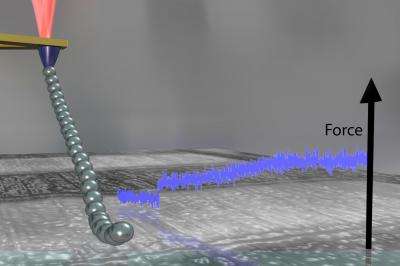Physicists discover a new kind of friction in the nanoworld

Whether in vehicle transmissions, hip replacements, or tiny sensors for triggering airbags: The respective components must slide against each other with minimum friction to prevent loss of energy and material wear. Investigating the friction behavior of nanosystems, scientists from the Technische Universitaet Muenchen have discovered a previously unknown type of friction that sheds new light on some previously unexplainable phenomena.
Friction is an omnipresent but often annoying physical phenomenon: It causes wear and energy loss in machines as well as in our joints. In search of low-friction components for ever smaller components, a team of physicists led by the professors Thorsten Hugel and Alexander Holleitner now discovered a previously unknown type of friction that they call "desorption stick."
The researchers examined how and why single polymer molecules in various solvents slide over or stick to certain surfaces. Their goal was to understand the basic laws of physics at the molecular scale in order to develop targeted anti-friction surfaces and suitable lubricants.
For their studies the scientists attached the end of a polymer molecule to the nanometer-fine tip of a highly sensitive atomic force microscope (AFM). While they pulled the polymer molecule over test surfaces, the AFM measured the resulting forces, from which the researchers could directly deduce the behavior of the polymer coil.
New friction mechanism discovered
Besides the two expected friction mechanisms such as sticking and sliding the researchers detected a third one for certain combinations of polymer, solvent and surface.
"Although the polymer sticks to the surface, the polymer strand can be pulled from its coiled conformation into the surrounding solution without significant force to be exerted," experimental physicist Thorsten Hugel describes this behavior. "The cause is probably a very low internal friction within the polymer coil."
The key is the solvent
Surprisingly, desorption stick depends neither on the speed of movement nor on the support surface or adhesive strength of the polymer. Instead, the chemical nature of the surface and the quality of the solvent are decisive. For example, hydrophobic polystyrene exhibits pure sliding behavior when dissolved in chloroform. In water, however, it shows desorption stick.
"The understanding gained by our measurement of single-molecule friction opens up new ways to minimize friction," says Alexander Holleitner. "In the future, with targeted preparation of polymers, new surfaces could be developed specifically for the nano- and micrometer range."
Provided by Technical University Munich
















